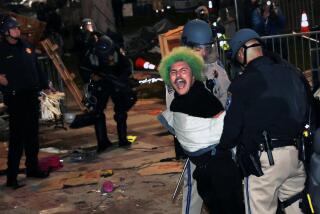Arizona sheriff hopes Russian-designed rubber-bullet handgun will save lives

Pinal County Sheriff Paul Babeu says his department will add to its arsenal a handgun that fires rubber projectiles.
- Share via
Reporting from Florence, Ariz. — In the open country along the Southwest border, law enforcement is often a game of distance and numbers. Smugglers, human traffickers and migrants entering the country illegally count on vast stretches of unguarded border to ensure safe passage.
That leaves Border Patrol agents and county sheriff’s deputies chasing people through open space, often at night, their targets too far for a stun gun, which can reach only about eight to 10 feet.
On Tuesday, the Pinal County Sheriff’s Office said it would become the nation’s first police agency at any level to use the Osa handgun, a Russian-designed four-chamber break-action pistol that uses a laser target pointer and shoots rubber bullets. It’s a weapon they say will lead to more captures and fewer deaths on the border.
“Illegal immigrants don’t generally have guns, but they could be throwing rocks,” said Pinal County Sheriff Paul Babeu, who demonstrated the weapon’s accuracy by striking a target from 15 feet away. “I’ve seen those incidents end with someone getting shot, someone getting killed.”
NEWSLETTER: Get the day’s top headlines from Times Editor Davan Maharaj >>
With a less lethal option, Babeu said, the number of deaths will fall.
The rubber bullets from the Osa, named for the Russian word for “wasp,” strike targets with the force of a person swinging a baseball bat or a punch from a professional boxer, said Leao Gitirana, spokesman for the American distributor of the gun, Defenzia. The rounds have blunt edges and are not designed to pierce.
“Pain compliance is what we’re looking for,” Gitirana said.
Law enforcement agencies have been searching for the ideal nonlethal weapon for years, and that goal has taken on greater urgency in recent years as fatal police shootings have come under greater scrutiny.
Pinal County’s announcement came the same day a veteran Chicago police officer was charged with first-degree murder in the killing of 17-year-old Laquan McDonald. In Minneapolis, protests continue over the fatal police shooting of Jamar Clark, 24.
Despite the goal of reducing deaths, nonlethal weapons are not without controversy. The Los Angeles Times reported last month that Tasers became instruments of excessive force after the Border Patrol issued them to its agents in 2008.
The Osa and its stun-gun ilk are popular in Russia, especially among the rich and those in major cities, according to a 2013 poll by the Russian Legal Information Agency.
Guns that fire rubber bullets attained brief notoriety in Russia after an argument about the merits of philosopher Immanuel Kant in a southern Russian bar devolved into violence in October 2013. One man fired several rubber bullets at his philosophical opponent, who was injured but not killed.
But Russia has been wrangling with the safety and legality of rubber-bullet guns for years. In downtown Moscow in 2007, a 29-year-old Azerbaijani pulled an Osa handgun and fired at a group of pedestrians, injuring three people he thought were crossing a street too slowly.
The Guardian newspaper, citing Russian government statistics, reported that 70 people were killed and 600 people injured by rubber-bullet weapons in the country from 2006 to 2011.
“People tend to consider them toys,” Max Popenker, a Russian author and firearms expert, told The Guardian in 2013. “The use of knuckles to settle some personal disputes here, especially among youngsters, is almost socially acceptable, and a less lethal weapon is often considered just as a long-range way of kicking people.”
Babeu said deputies would use the Osa in situations in which subjects are not compliant but also don’t pose a lethal threat to a police officer.
See the most-read stories this hour >>
He pointed to the fatal shooting of Walter Scott in North Charleston, S.C., as an example of when the Osa could have been helpful to police. As documented in a witness’ cellphone video, North Charleston Officer Michael Slager fatally shot the unarmed Scott in the back as Scott fled a traffic stop.
“The bar has been raised much higher for us in law enforcement in some circumstances,” Babeu said. “Imagine if that officer -- he’s not only been fired, he’s facing murder charges -- imagine if he had access to something less lethal that can reach the distance [the Osa] can.”
The Osa handguns will cost the department $1,100 each and will be available to all Pinal County deputies early next year, Babeu said.
In addition to Russia, the weapon is also used in Israel and Brazil. The weapon can also fire flares, pepper-gel bullets and flash-bang rounds, which do not discharge a shot but produce a deafening noise and blinding light.
Despite the weapon’s intimidating look and violent purpose, Babeu said he expects it to save lives. With an increased focus on police use of lethal force, he said, the Osa may help avoid another North Charleston.
“This is a national conversation that’s going on,” Babeu said, “and it’s not going well for law enforcement.”
Twitter: @nigelduara
ALSO
Fatal police shooting of Tamir Rice justified, use-of-force expert says
Three are held in shootings of Black Lives Matter protesters in Minneapolis
L.A. Police Commission approves contract for next wave of LAPD body cameras
More to Read
Sign up for Essential California
The most important California stories and recommendations in your inbox every morning.
You may occasionally receive promotional content from the Los Angeles Times.














